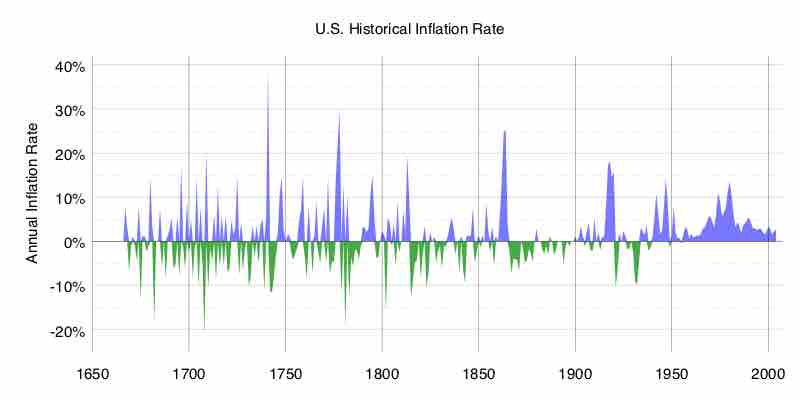In economics, deflation is a decrease in the general price level of goods and services. This occurs when the inflation rate falls below 0% (a negative inflation rate). Inflation reduces the real value of money over time; conversely, deflation increases the real value of money – the currency of a national or regional economy. In turn, this allows one to buy more goods with the same amount of money over time.
Economists generally believe that deflation is a problem in a modern economy because they believe it may lead to a deflationary spiral .

US historical inflation rates
Annual inflation (in blue) and deflation (in green) rates in the United States from 1666 to 2004
In the IS/LM model (Investment and Saving equilibrium/ Liquidity Preference and Money Supply equilibrium model), deflation is caused by a shift in the supply-and-demand curve for goods and services, particularly with a fall in the aggregate level of demand. That is, there is a fall in how much the whole economy is willing to buy, and the going price for goods. Because the price of goods is falling, consumers have an incentive to delay purchases and consumption until prices fall further, which in turn reduces overall economic activity. Since this idles the productive capacity, investment also falls, leading to further reductions in aggregate demand. This is the deflationary spiral.
An answer to falling aggregate demand is stimulus, either from the central bank, by expanding the money supply; or by the fiscal authority to increase demand, and to borrow at interest rates which are below those available to private entities.
In more recent economic thinking, deflation is related to risk: where the risk-adjusted return on assets drops to negative, investors and buyers will hoard currency rather than invest it, even in the most solid of securities. This can produce a liquidity trap. A central bank cannot normally charge negative interest for money, and even charging zero interest often produces less stimulative effect than slightly higher rates of interest. In a closed economy, this is because charging zero interest also means having zero return on government securities, or even negative return on short maturities. In an open economy it creates a carry trade, and devalues the currency. A devalued currency produces higher prices for imports without necessarily stimulating exports to a like degree.
In monetarist theory, deflation must be associated with either a reduction in the money supply, a reduction in the velocity of money or an increase in the number of transactions. But any of these may occur separately without deflation. It may be attributed to a dramatic contraction of the money supply, or to adherence to a gold standard or to other external monetary base requirements.
In mainstream economics, deflation may be caused by a combination of the supply and demand for goods and the supply and demand for money, specifically: the supply of money going down and the supply of goods going up. Historic episodes of deflation have often been associated with the supply of goods going up (due to increased productivity) without an increase in the supply of money, or (as with the Great Depression and possibly Japan in the early 1990s) the demand for goods going down combined with a decrease in the money supply. Studies of the Great Depression by Ben Bernanke have indicated that, in response to decreased demand, the Federal Reserve of the time decreased the money supply, hence contributing to deflation.
The effects of deflation are thus: decreasing nominal prices for goods and services, increasing buying power of cash money and all assets denominated in cash terms, possibly decreasing investment and lending if cash holdings are seen as preferable (aka hoarding), and benefiting recipients of fixed incomes.